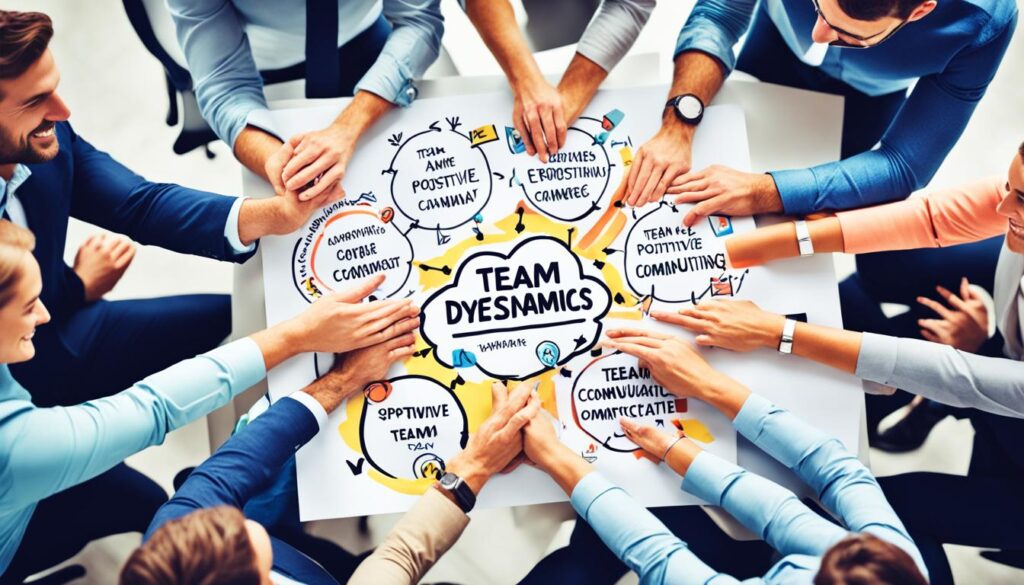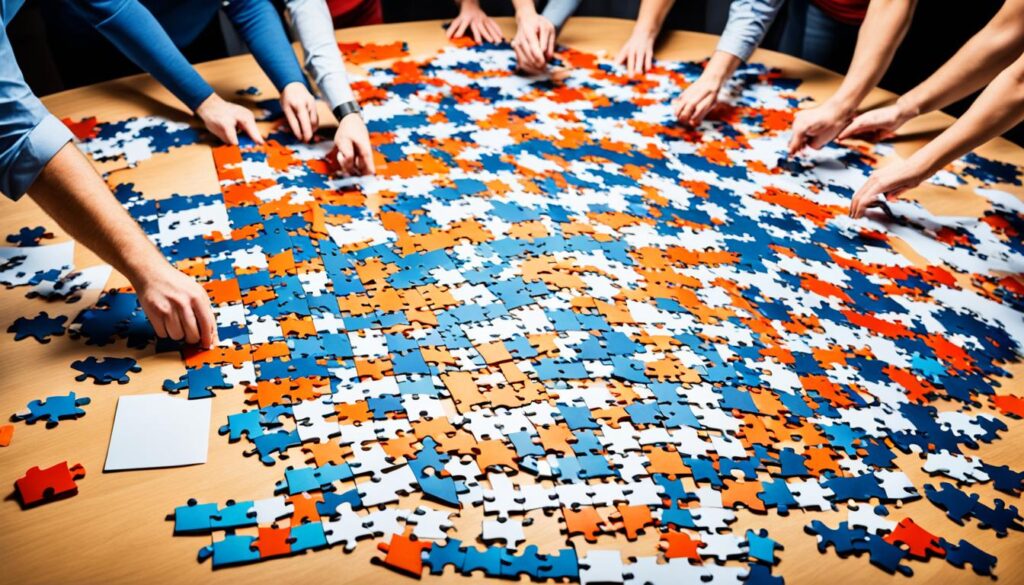Team dynamics and organizational behavior are key factors in fostering effective workplace collaboration and achieving group synergy. Understanding how team dynamics and organizational behavior influence group performance is essential for leaders and organizations seeking to create a productive and harmonious work environment.
Let me share a story that highlights the importance of positive team dynamics in the workplace:
At ABC Corporation, the marketing team was struggling to meet their targets. Despite having talented individuals with diverse skill sets, their output was subpar. Allison, the team leader, recognized that there was a lack of collaboration, transparency, and goal alignment within the team. She knew that something needed to change.
With the goal of improving team dynamics, Allison encouraged regular team meetings where each member had the opportunity to share their thoughts, concerns, and ideas. She implemented an open-door policy, ensuring that her team felt comfortable approaching her with any issues or suggestions.
Additionally, Allison organized team-building activities that focused on fostering trust, collaboration, and effective communication. These activities included team lunches, brainstorming sessions, and group projects where members had to rely on each other’s expertise.
The efforts paid off. As the team started to communicate more openly, they discovered hidden talents and untapped potential within themselves. They began to work together seamlessly, leveraging each other’s strengths and supporting one another through challenges. With enhanced team dynamics, they not only met their targets but also surpassed them, leading to increased customer satisfaction and recognition within the company.
This story exemplifies how positive team dynamics can transform a struggling team into a high-performing one. By fostering a culture of open communication, collaboration, and trust, leaders can unleash the collective potential of their teams, driving growth and innovation.
Key Takeaways:
- Positive team dynamics are crucial for workplace collaboration and individual and team performance.
- Effective communication and collaboration are key components of good team dynamics.
- Leaders can enhance team dynamics by fostering a culture of trust, transparency, and goal alignment.
- Regular team-building activities can help improve team dynamics and strengthen relationships among team members.
- Positive team dynamics contribute to increased productivity, innovation, and overall organizational success.
The Importance of Team Dynamics in the Workplace
Positive team dynamics play a crucial role in enhancing teamwork effectiveness in the workplace. When teams have good dynamics, they are more likely to achieve their goals, resolve conflicts effectively, and make better decisions as a group. A cohesive and collaborative team can achieve higher levels of productivity and innovation, leading to improved performance and outcomes.
One of the key benefits of positive team dynamics is leadership development. When team members trust and support each other, they are more likely to take on leadership roles and contribute their unique strengths. Positive team dynamics foster motivation and engagement among team members, creating an environment where everyone feels valued and empowered.
Conflict resolution strategies are also essential in maintaining healthy team dynamics. Conflicts are inevitable in any team, but how they are managed can significantly impact team dynamics. Open communication, active listening, and problem-solving skills are effective conflict resolution strategies that help teams address issues constructively. By encouraging open dialogue and finding mutually beneficial solutions, teams can strengthen relationships and maintain a positive team dynamic.
Effective team dynamics also promote clear communication and goal alignment. When team members understand their roles and responsibilities, as well as the overall objectives of the team, they can work cohesively towards achieving those goals. Transparent communication ensures that information flows freely, enabling teams to make informed decisions and stay on track.
“Positive team dynamics are key to achieving teamwork effectiveness, leadership development, and successful conflict resolution,” says Jane Williams, a team dynamics expert. “By fostering a supportive and collaborative team environment, organizations can unlock the full potential of their teams and drive better results.”
| Benefits of Positive Team Dynamics: |
|---|
| Enhanced teamwork effectiveness |
| Leadership development |
| Effective conflict resolution |
| Improved communication and goal alignment |
Understanding Team Dynamics and Its Components
Team dynamics play a crucial role in the success of any organization. Effective communication within teams and the group decision-making process are key factors that influence team dynamics. By prioritizing transparent and effective communication, leaders can create an environment where team members feel safe and included, fostering a positive team dynamic. This enables each member to express their ideas and concerns freely, leading to better collaboration and problem-solving.
In addition to communication, the group decision-making process also significantly impacts team dynamics. When decision-making is well-defined and collaborative, every team member has the opportunity to contribute their insights and perspectives. This not only encourages a sense of ownership and responsibility but also leads to more comprehensive and well-rounded decisions. By involving all team members in the decision-making process, leaders can strengthen team dynamics and promote a positive team environment.
Effective communication and inclusive group decision-making are vital components when it comes to understanding team dynamics. By fostering these aspects, leaders can enhance team collaboration, improve problem-solving capabilities, and create a positive team environment that drives success.
| Factors | Description |
|---|---|
| Effective Communication | Transparent and open communication promotes understanding, trust, and collaboration among team members. |
| Inclusive Decision-Making | Collaborative decision-making ensures that every team member’s insights and perspectives are valued and considered. |
| Shared Goals and Vision | Clear and shared goals align team members towards a common purpose, fostering unity and motivation. |
| Role Clarity | Clearly defined roles and responsibilities minimize confusion and promote accountability within the team. |
| Trust and Psychological Safety | A safe and trusting environment encourages team members to take risks, express their ideas, and learn from mistakes. |
Examples of Positive and Negative Team Dynamics
Positive team dynamics are crucial for a successful and harmonious work environment. In teams with positive dynamics, there is a clear alignment of goals and direction, open and honest communication, and a sense of accountability among team members. Let’s explore some examples of positive team dynamics:
Example 1: A sales team consistently achieves their targets by collaborating effectively, sharing information, and supporting each other. They celebrate each other’s successes and work together to overcome challenges.
Example 2: An agile development team practices continuous communication, ensuring that everyone is up-to-date with project progress. They actively seek feedback, share knowledge, and adapt to changes efficiently, fostering a culture of innovation.
Example 3: A healthcare team demonstrates strong teamwork while caring for patients. They communicate clearly, coordinate tasks seamlessly, and prioritize patient safety and well-being above all else.
On the other hand, negative team dynamics can have detrimental effects on team performance and collaboration. Here are some examples of negative team dynamics:
Example 1: A team experiences constant conflicts and disagreements due to a lack of trust and effective communication. This hampers their ability to make timely decisions and work together efficiently.
Example 2: A project team suffers from a lack of accountability, with team members frequently failing to meet deadlines or deliver high-quality work. This leads to frustration and an overall decrease in team productivity.
Example 3: A marketing team faces constant misunderstandings and misalignment of objectives, resulting in inconsistent messaging and missed opportunities. The lack of clear goals and responsibilities contributes to confusion and inefficiency.
Understanding the difference between positive and negative team dynamics is essential for leaders and team members alike. By recognizing the signs of negative dynamics, teams can take proactive steps to address issues, improve collaboration, and foster a more productive and harmonious work environment.

| Positive Team Dynamics | Negative Team Dynamics |
|---|---|
| Alignment of goals and direction | Lack of clarity in goals and responsibilities |
| Open and honest communication | Ineffective communication leading to misunderstandings |
| Accountability among team members | Lack of accountability |
| Collaboration and support | Poor collaboration |
| Trust and respect | Lack of trust |
| Effective conflict resolution | Unresolved conflicts |
Understanding the impact of team dynamics on performance and productivity is crucial for organizations. By fostering positive team dynamics and addressing negative dynamics, companies can unlock the full potential of their teams and achieve superior results.
The Five Stages of Team Dynamics
Team dynamics go through a series of five distinct stages, each serving a unique purpose in the team’s development. These stages are the forming stage, storming stage, norming stage, performing stage, and adjourning stage. Let’s explore each stage in detail:
Forming Stage
In the forming stage, team members come together and acquaint themselves with one another. They define their goals, roles, and expectations for the team. This is a crucial time for individuals to establish initial connections and build rapport.
Storming Stage
The storming stage is characterized by conflicts and disagreements among team members. As individuals assert themselves and voice their ideas, tensions may arise. This stage is crucial for working through differences and finding common ground.
Norming Stage
During the norming stage, team members establish norms, values, and expectations. This fosters increased cooperation, collaboration, and a sense of unity within the team. The focus shifts from individual needs to collective goals.
Performing Stage
The performing stage is when team dynamics are at their peak. Team members experience high productivity, synergy, and effective collaboration. They work together seamlessly, leveraging each other’s strengths, and achieving outstanding results.
Adjourning Stage
The adjourning stage occurs when a team reaches the end of its project or assignment. During this stage, team members reflect on their accomplishments, celebrate achievements, and prepare to move on to new endeavors.
Strategies to Improve Team Dynamics
Enhancing team dynamics is essential for fostering collaboration, productivity, and overall success within organizations. By implementing specific strategies, leaders can create a positive team environment that promotes open communication, conflict resolution, and goal alignment. In addition, leaders can leverage team collaboration strategies for leaders that focus on building trust and encouraging diverse perspectives, which are crucial for creative problem-solving. Regular team-building activities and open forums for feedback can also help strengthen relationships among team members. Ultimately, investing time and resources in enhancing team dynamics leads to improved morale and higher-quality outcomes for the organization.
Open Communication
Open communication is the foundation of effective team dynamics. Encouraging team members to express their thoughts, ideas, and concerns openly creates a transparent and trusting atmosphere. This fosters collaboration, promotes diverse perspectives, and develops strong interpersonal relationships. Regular team meetings, brainstorming sessions, and idea-sharing platforms can facilitate open communication within the team.
Conflict Resolution
Addressing conflicts in a constructive manner is crucial for maintaining healthy team dynamics. Conflict is a natural part of team collaboration, but when left unresolved, it can erode trust and hinder productivity. Leaders should encourage team members to communicate openly and listen actively to understand differing viewpoints. By facilitating constructive dialogue and guiding the process of conflict resolution, leaders can strengthen team dynamics.
Clear and Shared Goals
Establishing clear and shared goals enables team members to understand the purpose of their work and how it aligns with the broader organizational objectives. When everyone is on the same page, it promotes collaboration, cooperation, and a sense of collective responsibility. Leaders should ensure that goals are realistic, measurable, and communicated effectively to all team members, fostering a shared understanding and commitment.
Regular Feedback and Evaluation
Regular feedback and evaluation are vital for continuous improvement and development within a team. By providing constructive feedback and recognizing achievements, leaders can motivate and empower team members to grow professionally. Regular evaluations also allow for identifying strengths and areas of improvement, enabling targeted support and learning opportunities. Feedback should be timely, specific, and focused on actions, fostering a culture of accountability and performance excellence.
Visual Representation of Strategies

| Strategies | Description |
|---|---|
| Open Communication | Promote transparency and trust through effective communication channels and platforms. |
| Conflict Resolution | Encourage constructive dialogue and guide the team through conflict resolution processes. |
| Clear and Shared Goals | Define and communicate clear goals that are understood and embraced by all team members. |
| Regular Feedback and Evaluation | Provide timely feedback and evaluation to facilitate continuous learning and improvement. |
The Role of Organizational Behavior in Team Dynamics
Organizational behavior is a fundamental aspect of human resources in corporate settings. It encompasses various research areas that aim to enhance job performance, increase job satisfaction, promote innovation, and encourage effective leadership. Understanding and applying the principles of organizational behavior can significantly impact team dynamics and contribute to the overall success of a company.
One key area where organizational behavior plays a crucial role is in the recruitment and selection of candidates. HR professionals who are well-versed in organizational behavior theories and techniques can identify individuals who possess the necessary skills, traits, and values to fit into a team dynamic. By selecting candidates who align with the team’s goals and values, organizations can ensure a cohesive and harmonious team environment.
Furthermore, organizational behavior principles also inform the design of training programs. HR professionals can apply theories of organizational behavior to create training materials that cater to the specific needs and dynamics of the team. By providing targeted and relevant training, organizations can enhance team members’ skills, knowledge, and overall effectiveness.
Performance management is another area where organizational behavior comes into play. By adopting performance management systems that consider the impact of team dynamics on individual performance, organizations can foster an environment that encourages collaboration, accountability, and continuous improvement. This helps optimize team performance and achieve both individual and organizational goals.
Employee engagement is closely tied to team dynamics, and organizational behavior principles can provide valuable insights into fostering engagement. By understanding the factors that contribute to employee engagement, HR professionals can implement strategies to enhance team dynamics, such as promoting a positive work culture, encouraging open communication, and providing opportunities for growth and development.
Culture, both at the organizational and team levels, is heavily influenced by organizational behavior. By cultivating a positive and inclusive organizational culture, organizations can create an environment that nurtures and supports positive team dynamics. This includes fostering trust, promoting collaboration, and recognizing and rewarding team achievements.
Organizational behavior serves as a guide for HR professionals, providing them with the tools and knowledge needed to create an environment that fosters positive team dynamics. By applying the principles of organizational behavior in various HR practices, organizations can maximize team performance, improve collaboration, and achieve their strategic objectives.
Key Takeaways:
- Organizational behavior is essential in understanding and improving team dynamics in the workplace.
- It plays a vital role in recruitment, training, performance management, employee engagement, and culture.
- By applying principles of organizational behavior, organizations can create an environment that fosters positive team dynamics and maximizes team performance.
Conclusion
In conclusion, team dynamics and organizational behavior are crucial elements in fostering workplace collaboration and maximizing efficiency. Positive team dynamics not only contribute to improved team and individual performance but also fuel innovation and enhance customer satisfaction. By understanding the components and stages of team dynamics, leaders can implement strategies to create a positive team environment that encourages collaboration and synergy among team members.
Furthermore, organizational behavior principles play a vital role in shaping team dynamics and can be applied to various Human Resources practices. These practices include recruitment and selection, training and development, performance management, employee engagement, and the cultivation of a positive organizational culture. By incorporating these principles, companies can optimize team performance and achieve their organizational goals.
Ultimately, investing in team dynamics and organizational behavior is crucial for businesses looking to thrive in today’s competitive landscape. When teams work together effectively, communicate transparently, and have clear goals, the result is a collaborative and productive work environment that drives success. By prioritizing team dynamics in business studies, organizations can gain valuable insights into the factors that contribute to high-performing teams. Furthermore, fostering a culture that encourages collaboration and open communication not only enhances employee satisfaction but also leads to innovative solutions and improved decision-making. Ultimately, the focus on team dynamics translates into a sustainable competitive advantage, allowing businesses to adapt and excel in an ever-evolving market.
FAQ
What are team dynamics?
Team dynamics refer to the behavioral relationships between members of a group, including how they interact, communicate, and cooperate.
Why are positive team dynamics important in the workplace?
Positive team dynamics are crucial for workplace collaboration and can lead to improved team and individual performance, innovation, and customer satisfaction.
How can team dynamics enhance leadership development?
Positive team dynamics contribute to leadership development by fostering trust, motivation, and engagement among team members.
What strategies can be used to improve team dynamics?
Strategies to improve team dynamics include open communication, conflict resolution skills, establishing clear and shared goals, and regular feedback and evaluation.
What is the role of organizational behavior in team dynamics?
Organizational behavior plays a crucial role in team dynamics and is a foundation of corporate human resources. It encompasses research areas dedicated to improving job performance, increasing job satisfaction, promoting innovation, and encouraging leadership.


